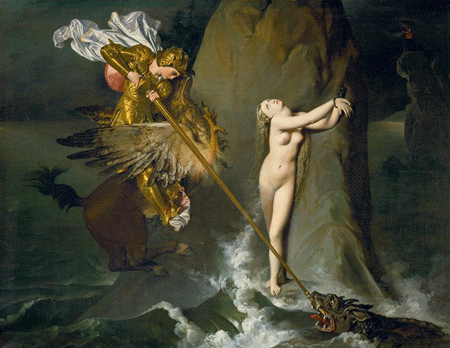Ingres vs Delacroix: An artistic rivalry spills over at a party

Left: Jean-Auguste-Dominique Ingres | Self Portrait, 1858 | Galleria degli Uffizi Image and original data provided by SCALA, Florence/ART RESOURCE, N.Y. artres.com | (c) 2006, SCALA, Florence / ART RESOURCE, N.Y. Right: Eugène Delacroix | Self-Portrait, c. 1837 | Musée du Louvre | Image and original data provided by Erich Lessing Culture and Fine Arts Archives/ART RESOURCE, N.Y. artres.com
The rivalry between Jean-Auguste-Dominique Ingres and Eugene Delacroix, the two titans of 19th century French painting, is often seen as embodying the conflict between the era’s tradition-based neoclassicism and non-conformist Romanticism. Writing for the journal Art History, Andrew Carrington Shelton quotes an article from 1832 by an anonymous critic as the first time the dispute was presented:
It’s the battle between antique and modern genius. M. Ingres belongs in many respects to the heroic age of the Greeks; he is perhaps more of a sculptor than a painter; he occupies himself exclusively with line and form, purposefully neglecting animation and colour […] M. Delacroix, in contrast, willfully sacrifices the rigours of drawing to the demands of the drama he depicts; his manner, less chaste and reserved, more ardent and animated, emphasizes the brilliance of colour over the purity of line.
The antagonism seems to have extended into the personal. In 1883, the New York Times featured a surprisingly gossipy account of a party in which the two stars had a confrontation. The famously testy Ingres doesn’t come across too well in the exchange:
After dinner, holding in his hand a cupful of coffee, he brusquely went up to Eugene Delacroix, who was standing by the fire, and said to him: “Drawing, sir, drawing is honesty! Drawing, sir, drawing is honor!” In his agitation the cup of coffee capsized and poured over his shirt and waistcoat. He seized his hat in a fury… “This is too much! I shall go; I will not let myself be insulted any longer.”
After Ingres left, Delacroix showed admirable restraint, speaking of the qualities that made lngres an eminent painter, adding: “Talent is apt to be exclusive: narrowness is often the condition of its existence.”
- Jean-Auguste-Dominique Ingres | Roger and Angelica, 1819 | Musée du Louvre | Image and original data provided by Erich Lessing Culture and Fine Arts Archives/ART RESOURCE, N.Y. artres.com
- Jean-Auguste-Dominique Ingres | The Grand Odalisque, 1814 | Musée du Louvre | Image and original data provided by Erich Lessing Culture and Fine Arts Archives/ART RESOURCE, N.Y. artres.com
For this slide show, we searched the Artstor Digital Library for some images that highlighted the formal differences between the two artists. Among the hundreds of choices, we chose these examples from the Réunion des Musées Nationaux, the Erich Lessing Culture and Fine Arts Archives, and the Scala Archives. From viewing the artworks alone, could you have predicted which of these two artists would be more likely to get so agitated at a party that he would spill coffee on himself?


